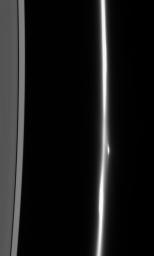
|
Unfocused F Ring
- Click the image above for a larger view
- Full-Res JPEG (608 x 1010) (19.0 kB)
- Full-Res TIFF (608 x 1010) (614.9 kB)
Caption:
The F ring dissolves into a fuzzy stream of particles -- rather different from its usual appearance of a narrow, bright core flanked by dimmer ringlets. Also notable here is the bright clump of material that flanks the ring's core.
This view looks toward the unlit side of the rings from about 58 degrees above the ringplane.
The image was taken in visible light with the Cassini spacecraft narrow-angle camera on Feb. 10, 2007 at a distance of approximately 1.7 million kilometers (1.1 million miles) from Saturn. Image scale is 10 kilometers (6 miles) per pixel.
Background Info:
The Cassini-Huygens mission is a cooperative project of NASA, the European Space Agency and the Italian Space Agency. The Jet Propulsion Laboratory, a division of the California Institute of Technology in Pasadena, manages the mission for NASA's Science Mission Directorate, Washington, D.C. The Cassini orbiter and its two onboard cameras were designed, developed and assembled at JPL. The imaging operations center is based at the Space Science Institute in Boulder, Colo.
For more information about the Cassini-Huygens mission visit http://saturn.jpl.nasa.gov/home/index.cfm . The Cassini imaging team homepage is at http://ciclops.org .
Cataloging Keywords:
| Name | Value | Additional Values |
|---|---|---|
| Target | Saturn Rings | F Ring, Saturn |
| System | Saturn | |
| Target Type | Ring | Planet |
| Mission | Cassini-Huygens | |
| Instrument Host | Cassini Orbiter | |
| Host Type | Orbiter | |
| Instrument | Imaging Science Subsystem (ISS) | |
| Detector | Narrow Angle Camera | |
| Extra Keywords | Clump, Grayscale, Visual | |
| Acquisition Date | ||
| Release Date | 2007-04-02 | |
| Date in Caption | 2007-02-10 | |
| Image Credit | NASA/JPL/Space Science Institute | |
| Source | photojournal.jpl.nasa.gov/catalog/PIA08908 | |
| Identifier | PIA08908 | |
